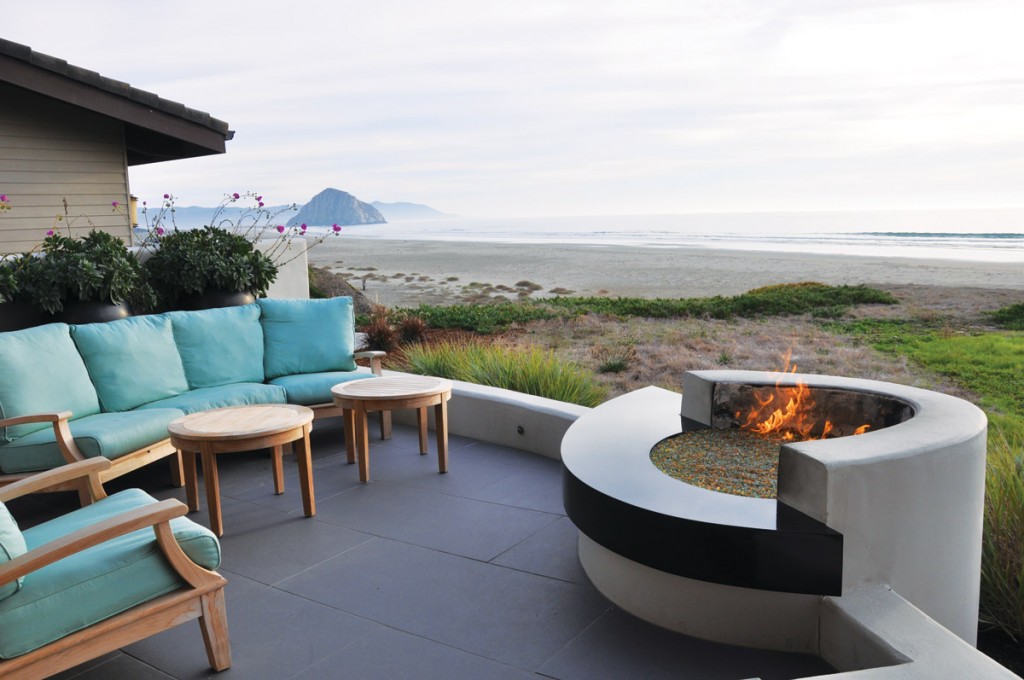Jeffrey Gordon Smith spends a good deal of his time analyzing everything from the exact color of sand to the dimensions of his dinner plate. As a man driven by the pursuit of aesthetic perfection, this constant state of scrutiny is beneficial to his chosen profession. Carefully considered representations of big-picture ideas and supporting details are imperative for a designer’s success. “It’s like looking through many different lenses,” says Smith, “…like zooming in and stepping way back and going wide.” It is this telescopic approach that enables the landscape architect to cull from a site its inherent nature and unique appeal.
With offices in California’s Baywood Park, Smith is well versed in coastal architecture and conditions. His residential, commercial, and institutional projects all illustrate what he calls “informative landscape designs,” which result from the thorough exploration of a property and its geographic location. Smith values three-dimensional interpretations of sites, which allow him to understand both the existing and possible connections between place, architecture, and client. “Seventy percent of design is on paper,” he says, adding, “30 percent is in the field. There is such insight in being on site.” For Smith, this close-up investigation of a landscape, its established structures, and a client’s own story all play essential roles in his design process, as he works to wed all three in such a way as to blur their lines, thereby weaving together the physical and the psychological, the visible and the private. He describes his Jewel Box Design project as one such example; drawing ideas from a client’s recent loss of a spouse and her penchant for sea glass, Smith turned a tight, unused corridor between her garage and home that had previously collected trashcans, ladders, and the like into an element-rich, restorative space.
Exploring clients’ homes and hearing their ideas help Smith gain a sense of who they are, which provides information that can be used to flesh out a design concept. “I try to open up a dialogue,” says Smith, “to get into their thinking [and] understand how they view the landscape.” People, he has learned, have strong associations with their surroundings and interpret the environment through a very subjective lens—their personal sense of place. Smith sees clients attempting to impose on landscapes an appreciation for other regions, though no relationship exists between those places and the properties on which they live. He cites the example of a client native to Sweden who envisioned the grasses of his homeland thriving in his serpentine, rock-riddled soils. “It’s human nature to want what you can’t have,” he says. “That’s the bane of all gardeners.” His work includes helping clients be more connected to their present environments and to value their regions’ unique characteristics; people, he feels, need to understand where they are, what they have, and how to use it. This idea, sometimes termed “regionalism,” entails developing a cohesive design that melds with a site’s wider context, and it is part and parcel of Smith’s success. “I am very passionate about what I do, and I think that passion comes through,” he says. “Clients start picking up my enthusiasm for the particular specialness of their place and [they] start to understand that they need to work with it.”
Smith is a valuable designer; to each new project he brings with him an arsenal of information about plants that cannot be gleaned from books. “You start picking up these notes and carrying them along the way,” he says. “That’s why, I think, they call it ‘practice.’” These “notes” are compiled from years of planning, installing, and revisiting landscapes, both after installation and many years later. “You have to step back and be critical of your [designs],” Smith says. “If clients are going to hire me, they are going to hire me for the life of the garden.” It is this vested interest in his landscapes, combined with his sensitivity to site and client, that lead his ideas to successful fruition time and again. The gardens he orchestrates are thoughtful, well planned, and inspired. More importantly, they belong—to both client and place.
Muted tones borrowed from the surrounding seascape
While still a student at California Polytechnic State University, Smith became fascinated with the concept of genius loci, or “the spirit of a place.” The idea took root and bloomed into the central theory now behind his work. “People try to re-interpret nature and replicate it,” he says, “but [we] can’t compete…if you try, you are just planting seeds and staging it, but nature will eventually take over.” Instead, Smith says, “I try to abstract it as a painting,” which may be an approach influenced, in part, by his admiration for the work of British artist Andy Goldsworthy. Part sculptor, photographer, and environmentalist, Goldsworthy produces site-specific “land art” in natural and urban settings that Smith describes as “poetry.” “[Goldsworthy] synthesizes something out of the landscape [that’s] so simple, so articulate. I’m painting with different materials…I like to step back and ask, ‘What feels native, or what feels of the place?’” By doing so, he says, his palette widens to include a much larger group of plants and possibilities.
In addition to ideas mined from his clients’ lives, the pre-existing site conditions, and other artists’ works, narratives often drive Smith’s designs. A commission for his alma mater’s engineering department plaza, for example, was a $1 million project based on Fibonacci’s mathematical algorithm—the consequence of which is the infinite spiral. “I don’t like to get too artsy on people,” says Smith, “[or] to go too far out there, but I think sometimes you have to go out there to sympathize with the bigger idea and make a connection to that place.” For this project, Fibonacci’s “story” steered the entire design, right down to plant choices. It was Smith’s intent that current engineering, botany, and horticulture students study the plaza from their different academic perspectives, and that generations of students’ stories emerge from use of the space. “In the way that the spiral continues to expand,” says Smith, “so does the story. It’s an ever-giving, ever-expanding concept [with a] strong connection to all things natural. Nature is not chaotic, it is mathematical.” It is this appreciation for logic’s influence on nature that inspired the plaza’s sound design and allegory at its center.
Sculpting landscapes in accordance with contextual conditions and clients’ demands presents some challenges. Imposing architecture, for example, or code restrictions can greatly affect design choices, development, and execution. “Trying to make coastal interpretations without crossing any lines is [difficult],” says Smith, who notes the strict regulations for building seawalls as particularly difficult to hurdle. Determining sightlines that clients wish to block and those they’d like to “borrow,” as in the case of desirable views, requires good strategic planning. Transitioning from outer to more intimate settings demands great skill. “I’m always squinting to find the natural cues and to see what connects a property to the larger landscape,” he says, “clues [like] escaped colors and plants from outside that can be used to bleed out from a home’s own landscape.” According to Smith, if the connection between home and place is not made seamlessly, “it [looks] like a fabric [is] sewn onto another fabric with a pattern change made by an ugly suture.” No matter the obstacles, he prefers some kind of springboard from which to begin a new project. Whether a disagreeable architectural style, a client’s insistence on pink pavers, or a site’s overabundance of serpentine rock, Smith feels ideas are more easily generated when there are a few constants in the mix. His wide-lens approach ensures there is always something at the ready. “The blank slate is the hardest to work with,” says Smith. “It’s the ultimate challenge.”
Though conscious of the many details that go into a winning design, Smith’s primary aim is to get the most impact from the “big idea”—the overriding concept is what he wants felt, if not cerebrally understood. “I think of myself as a temporary artist,” he says. “Landscapes are going to fail, they are totally contrived pieces of nature…always evolving and changing.” To connect clients with their environment in an intimate and meaningful way, Smith pushes them to revisit their perceptions of what “landscape” is. “Right now it’s all about man controlling nature,” he says. “But, I think in the future it will be about man living with nature and having more of a connection to it.” It’s this vision that has Smith carefully stitching private gardens together with their surrounding environs. He uses choice materials, a practice hand, and a laser-sharp eye. The results are seamless.




